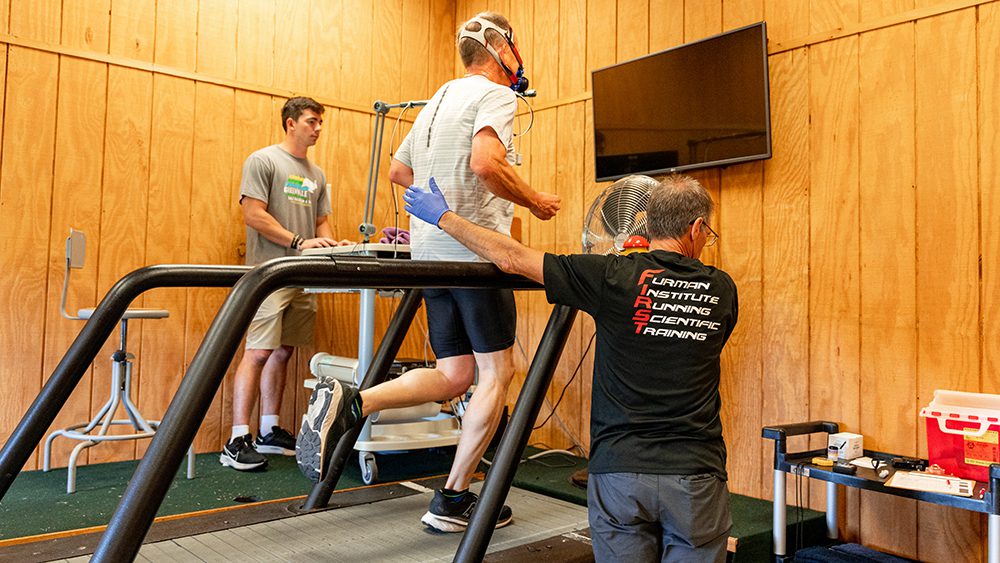Furman FIRST clinic running strong after 20 years

In 2003, Scott Murr and Bill Pierce, health sciences faculty at Furman University, started a running clinic where they taught principles and training techniques to everyday runners using scientific data based on a principle that cut against the conventional wisdom of the day: run less, run faster.
Twenty years later, with three years off for the COVID-19 pandemic, the Furman Institute of Running and Scientific Training (FIRST) clinic is still attracting people from all over the world, from the United Kingdom to Venezuela, Spain to Mexico, and almost every state in America.
This year’s clinic took place over four days in the first week of June. Fifteen men and women came from as far away as Colorado, New Jersey and three different provinces in Canada.
Participants in the clinic aren’t elite racers, they’re runners who simply want to get better, Murr said. “They have goals. They might want to qualify for The Boston Marathon (or “BQ), or they might have dealt with injuries or have plateaued in their fitness.” This June, an 83-year-old woman from Kansas came to improve her stride. Some runners come back for tune ups.
In Regina, Saskatchewan, Canada, Lane Rathgeber, 51, read about the clinic in “Run Less, Run Faster,” the groundbreaking book Murr and Pierce wrote based on their work. A runner for 20-plus years, he’s logged seven marathons and countless shorter races. His best times were a decade ago, and he’s missed the coveted BQ by eight to nine minutes. He came to FIRST, he said, “to discover how fast I’m capable of running now, before I get too much older. A BQ would be a bonus. … It was everything I expected and more.”
Rathgeber and his fellow runners spent the first day going through physiological tests to measure body composition, VO2 max and lactate threshold, and running on an oversized treadmill while Murr and others analyzed their gait. The next two and a half days were spent going over their results and learning about cross training, strength training, injury prevention, flexibility, goal setting and race strategies. The gym work elaborated on the material Murr and Pierce covered in their book, Rathgeber said. And, or course, they ran.
Furman students get involved in the clinic, helping conduct the physiological tests, getting real-world experience they probably couldn’t get elsewhere. Jill Lucas ’07 came up with the idea for the clinic during her senior year at Furman. Now an assistant professor of exercise physiology at The University of Lynchburg, she comes back to Furman every year to help. Phil Gregory, a physical therapist and supervisor at St. Francis Therapy Center at Furman Sports Medicine, provides key input on biomechanics.
The program, Murr said, is the same they offered 20 years ago. “The science on endurance running hasn’t changed” but he and Pierce polished it, Murr said. Pierce retired in 2019 yet remains active and can frequently be found working out on campus in the Physical Activities Center.
In the 1970s, as a high schooler in Thomasville, North Carolina, Murr started running with his dad. The two would run three one-mile laps around their neighborhood. It was more than exercise; it was a bonding experience.
Murr kept running in college at Furman and in 1983 he started running, and bonding, with a new faculty member, Pierce. When they started doing triathlons together, they had to cut back on training runs to pick up swimming and cycling. They expected their run times to get slower, believing the adage that runners got faster by running, and slower but running less. But that didn’t happen. Their run times stayed the same. Not only could they maintain pace, but they reduced running-related injuries by cross training. Not only did they maintain pace, but they reduced running-related injuries and burnout by incorporating swimming and cycling.
They spent years testing a new theory: run less to run faster. They threw out junk miles, the padding runners believed they needed, and became more strategic. They began preaching their new gospel, offering free clinics around Greenville, which caught the attention of the runner’s most trusted resource, Runner’s World magazine. A 2006 cover story by editor Amby Burfoot led to worldwide acclaim and a book deal. “Run Less to Run Faster” is now in its third edition.
“It’s been a wonderful experience for Bill and myself, Murr said. “I’m appreciative of what we’ve offered runners and the opportunities we’ve offered our students.”
Rathgeber said his training is going well, and he’s confident he’ll discover just how fast he’s capable of running in his next race, a half marathon in September, and possibly in another marathon within the year.
And the clinic? You can count on it to keep running.